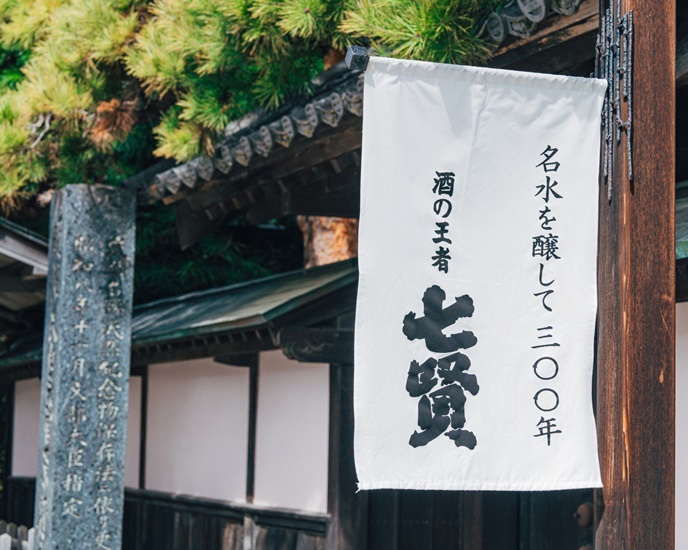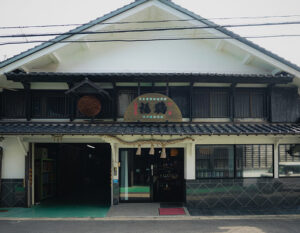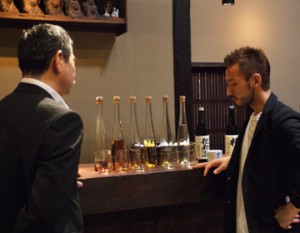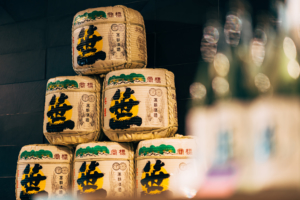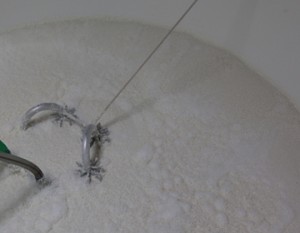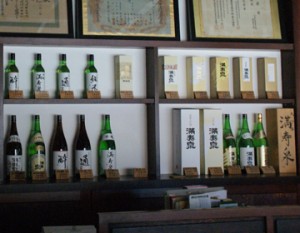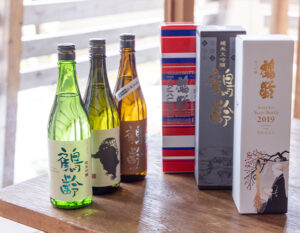Located at the northern end of the Southern Alps range at the foot of the famous 2,967-meter-high “Kaikomagatake” mountain, the area has a long history of mountain climbing by mountain ascetics and mountain worship called “Komagatake-ko”. When you visit the Kai-komagatake Shrine, where the history of mountain climbing by ascetic practitioners and mountain worship called “Komagatake-ko” is still alive, you will find a path leading to the source of the famous sake “Shichiken,” which has been brewed for about 300 years.
Like “water from Hakushu.”

I want to make sake that embodies the calm and pleasant water of Hakushu,” said Mr. Tsushima Kitahara as he walked along the Ojiragawa Valley, one of the 100 best waters in Japan, in the western part of Hakushu Town, Hokuto City, Yamanashi Prefecture. He is the president of “Yamanashi Meijo Co., Ltd.” which brews the famous sake “Shichiken” in Daigaharajuku, the 40th post town on the old Koshu Highway. Now in its 13th generation, some 300 years after its founding, the company produces a wide variety of brands, including “Shichiken Sparkling,” which was created in 2015, in addition to its traditional ginjo-shu.

Mr. Tsushima says, “This is a place that symbolizes our sake brewing process, where we face the water. The main ingredients of sake are rice, rice malt, and water. Kaikomagatake is a mountain composed of granite, which is formed when underground magma cools and hardens. The melted snow water, polished by the rock layers over 20 years, is clear, soft, slightly thickened, and soft. The clear, soft, and slightly thickened soft water, which is non-habitant and easy to drink, gives Shichiken a well-honed flavor.
Mr. Tsushima also insists on sake rice grown in Hokuto City. In 1999, he established an agricultural corporation, Onakaya Limited, which grows high-quality rice such as “Yumesansui” and “Hitogochi” together with local farmers and producers. The water, the rice they grow, and all the ingredients used in Shichiken are made possible by the bounty of nature in the region.”
300 Years of Streamlines

The brewing of Yamanashi Meijo began in 1750. Ihee Nakaya of the Kitahara family, who had been in the brewing business in Takato, Shinshu (present Takato-machi, Ina City, Nagano Prefecture) for generations, fell in love with the soft, clear water of Hakushu when he visited Daigahara, and built a sake brewery as a branch family. In 1835, when the fifth generation brewer built a new main building, Naito Suruganomori, the lord of Takato Castle, whom he had served for a long time, presented him with a gift for the completion of the new building, including three of the seven wise men of the Jin Dynasty in China who avoided worldly cares and lived in bamboo groves, drinking sake and enjoying pure conversation: Ruan Xue, Xie Kou The current name of the sake, “Shichiken,” was given to the sake, as a pair of columns depicting the “Seven Sages of the Bamboo Forest” depicted Ruan Xue, Xiang Shu, Liu Ling, Ruan Xian, and Wang Ebisu.
In 1880, the back room of the main building was used as an anzai-sho for the Emperor Meiji when he visited Yamanashi, Mie, and Kyoto prefectures. In 1933, this place was designated as a Tangible Cultural Property of Yamanashi Prefecture by the Ministry of Education (now the Ministry of Education, Culture, Sports, Science and Technology).
In 1925, “Yamanashi Meijo Co., Ltd.” was established as a corporation. In 1967, a new brewery, Seiwa Brewery, was built, and in 1980, a new bottling factory and warehouse were constructed, establishing the current structure of Yamanashi Meijo.
Pumping up the “Seven Sages’ character”

Mr. Tsushima spent three years from 2003, the year he graduated from university, at an American liquor import company. After joining Yamanashi Meizo in 2007, he launched a series of bold reforms.
In 2012, we embarked on a major rebranding strategy. Together with my younger brother, I visited breweries and wineries around the country to try to create a new sake that was ‘uniquely Shichiken.
Until then, the brewing process had been outsourced to a contractor specializing in brewing called a toji, but the aging of the toji and the diversification of customer needs led to the discontinuation of this policy. In 2014, his younger brother, Ryogo Kitahara, was appointed brewing director, and the company embarked on sake brewing with a focus on water, which symbolizes regional characteristics and identity.
We began to verbalize and redefine what we wanted our sake to be like,” he said, ‘’aromatic and fresh tasting,‘ ’sake to be enjoyed chilled in a wine glass. The brewing equipment at the Seiwa Brewery was updated to the latest models to create a stable, high-quality sake brewing environment. We also attempted to reestablish a “Shichiken-like” flavor that maximizes the mouthfeel and characteristics of high-quality water, and we tried to renew the label design to appeal to a new target audience.
“Squeeze” to deliver

Even if you have a large lineup of products, only some of them will sell. The reality is that wholesalers only sell what they can sell. Mr. Tsushima says that his own wholesale experience has made him concerned about the sales system that relies on intermediaries. In order to create “an environment where producers can sell their products responsibly,” Tsushima carefully scrutinized his existing business partners and narrowed his focus to “partners” who share Shichiken’s thoughts and marketing policies, thereby improving sales efficiency.
Yamanashi Meijo had been producing many brands, including old sake, draft sake, and seasonal products, but after the re-branding, the lineup was drastically and carefully selected. The company has been able to reduce brewing costs and excess inventory while devoting resources to developing products that are more in line with user demand.
The birth of Shichiken Sparkling

Behind Shichiken’s efforts to develop the market is the “Shichiken Sparkling” series, which took about five years to develop. While 70% of all alcohol consumed in Japan is carbonated sake, only 4.8% of sake users are carbonated. In order to bring Shichiken to users who had not previously drank sake, we needed a ‘bubbly’ drink.
Second fermentation is necessary to make sake effervescent, but it was difficult to use yeast due to brewing restrictions. Therefore, the company introduced the “secondary fermentation in bottle” method, in which the sake is made effervescent through spontaneous fermentation by bottling the rough residues of the rough unrefined sake mash. After much trial and error regarding the timing of fire-fermentation, fermentation temperature, and duration, Yamano Kasumi was released in 2015. It was well received for its koji sweetness, mild acidity, and fruity ginjo aroma with carbonation. Later, “Hoshi-no-Kagayaki” was released, characterized by its delicious rice flavor and pure aroma, and “Mori-no-Kanade” was released, with a cool, refreshing aroma created by aging in whiskey barrels. The company established “Nanaken Sparkling” as a new category, spurring the company to attract new users.
After these rebranding efforts, in the year of Heisei 30 (2018). Mr. Tsushima became president and his younger brother, Ryoko, became managing director. He said, “Although we have different personalities, we are still brothers. Because we share the same sense of ‘deliciousness,’ I was able to trust them with the brewing of our sake. Mr. Tsushima concentrates on marketing and branding strategies while Mr. Ryoko handles brewing and product development. By fulfilling their respective roles as “maker” and “deliverer,” the 300-year-old tradition of excellent sake has been passed down to the present day.
Co-performance with French master “Mr. Alain Ducasse”

In recent years, wine and champagne have become available at sushi and Japanese restaurants, and Mr. Tsushima says he felt a sense of crisis that the common practice of pairing Japanese food with sake was beginning to fade. With an eye on market development and overseas expansion, he decided to venture into the French cuisine world, which he had not yet entered. At that time, he met Alain Ducasse, a master of French cuisine who has opened restaurants all over the world, including 3-star restaurants in Paris, Monaco, and London.
He was very interested in sake,” said Mr. Ducasse. ”Recently, an increasing number of bistros and gastronomes have started to serve sake, but Mr. Ducasse himself had not found anything that satisfied his taste buds. So, based on the Shichiken Sparkling, he asked us to create a sake with a Japanese character that would make gourmets around the world nod their heads in approval.
In order to embody “Japaneseness,” Tsushima and his team tried a method of aging sake in cherry blossom barrels prior to secondary fermentation. The result is a pleasant taste with a delicate bubbly aroma with a hint of cherries and a lingering sweetness and bitterness characteristic of barrel aging. In April 2021, “Alain Ducasse Sparkling Sake” will be completed, which will elegantly color your table from aperitifs to desserts.
The new product, which was highly acclaimed by Mr. Ducasse, has been well received by Champagne users who have a high affinity for sparkling wine, and a certain number of orders have been received from restaurants in the Alain Ducasse group and other overseas restaurants. Mr. Tsushima says, “I hope this will be an opportunity for people around the world to discover Japanese sake. We have high expectations for this product as a breakthrough in future market development.
Seven Sages’ “Spirits” Connecting Clear Streams

Yamanashi Meibrewery is currently using renewable energy from hydroelectric power to supply all of the electricity used at the factory in order to further promote sustainable sake brewing. The company also plans to replace LPG (liquefied petroleum gas) with hydrogen at a new plant to be built around 2030. Under these various measures, the distilled spirit “Alain Ducasse Sustainable Spirits” will be released in December 2023.
In the course of discussions with Mr. Ducasse, we recognized anew the demand for products for hard liquor users. We proposed to make authentic shochu by reusing sake lees.
In order to obtain a shochu (spirit) that has the gorgeous aroma of sake, the alcohol extracted from sake lees is aged in the barrels of Suntory’s Hakushu Distillery, which also makes whiskey in the Hakushu area. The unique ginjo aroma of Shichiken emphasizes the cool and refreshing taste, and the mellowness characteristic of barrel aging and the multi-layered and complex flavor have been successfully created.
We feel it is our duty to embody a mentality and behavior that is considerate of the natural environment in order to preserve the clean water of Hakushu for future generations.” After distillation, the nutritious sake lees are reused to feed the wagyu cattle that represent Yamanashi Prefecture, and the compost is used to grow sake rice again. In addition to the taste, the brewery’s cyclical brewing design, which is appropriate for the times, has been well received by Mr. Ducasse, and is attracting attention from users in Europe, who are highly interested in SDG’s.
Brewing sake that is “calm and comfortable”.

Finally, Mr. Tsushima looks back on the past 10 years as a “turbulent period,” a period in which the company has been running unceasingly until today. Shichiken’s business performance has doubled since before the rebranding, and the company’s needs continue to grow, but the company is now looking ahead to a “period of stability. While the pursuit of profit is important, the next step is to build a foundation that will allow the brewery to produce stable, high-quality sake for the next generation, he says.
If we increase the speed of growth in the dark, there is bound to be a distortion somewhere. We would like to establish our own style and pace, not being overly influenced by demand, in order to provide sake that we can confidently call ‘delicious,’ while using the knowledge we have gained thus far as a source of inspiration.
While considering future expansion of facilities, Mr. Tsushima says, “We want to continue to grow in a calm and comfortable manner. With a gentle smile on his face, he concluded his words in a relaxed and refreshing tone. While respecting the origins of sake brewing, Shichiken continues to maintain a flexible attitude, free from the constraints of the industry and common sense. The company’s pure desire to deliver delicious sake and its keen sensitivity to the currents of the times have refined the taste and techniques of its brewery.




